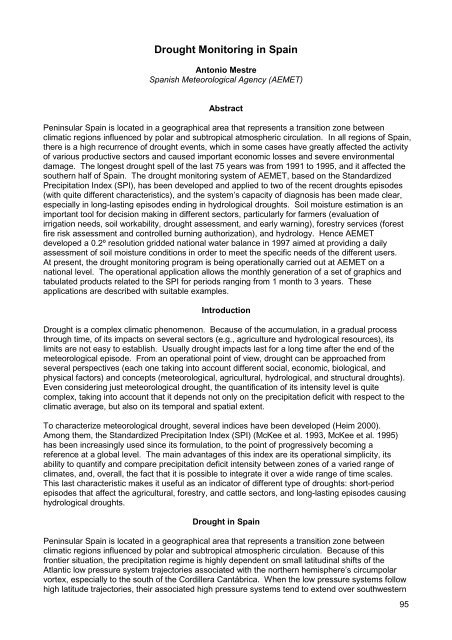Agricultural Drought Indices - US Department of Agriculture
Agricultural Drought Indices - US Department of Agriculture
Agricultural Drought Indices - US Department of Agriculture
Create successful ePaper yourself
Turn your PDF publications into a flip-book with our unique Google optimized e-Paper software.
<strong>Drought</strong> Monitoring in Spain<br />
Antonio Mestre<br />
Spanish Meteorological Agency (AEMET)<br />
Abstract<br />
Peninsular Spain is located in a geographical area that represents a transition zone between<br />
climatic regions influenced by polar and subtropical atmospheric circulation. In all regions <strong>of</strong> Spain,<br />
there is a high recurrence <strong>of</strong> drought events, which in some cases have greatly affected the activity<br />
<strong>of</strong> various productive sectors and caused important economic losses and severe environmental<br />
damage. The longest drought spell <strong>of</strong> the last 75 years was from 1991 to 1995, and it affected the<br />
southern half <strong>of</strong> Spain. The drought monitoring system <strong>of</strong> AEMET, based on the Standardized<br />
Precipitation Index (SPI), has been developed and applied to two <strong>of</strong> the recent droughts episodes<br />
(with quite different characteristics), and the system’s capacity <strong>of</strong> diagnosis has been made clear,<br />
especially in long-lasting episodes ending in hydrological droughts. Soil moisture estimation is an<br />
important tool for decision making in different sectors, particularly for farmers (evaluation <strong>of</strong><br />
irrigation needs, soil workability, drought assessment, and early warning), forestry services (forest<br />
fire risk assessment and controlled burning authorization), and hydrology. Hence AEMET<br />
developed a 0.2º resolution gridded national water balance in 1997 aimed at providing a daily<br />
assessment <strong>of</strong> soil moisture conditions in order to meet the specific needs <strong>of</strong> the different users.<br />
At present, the drought monitoring program is being operationally carried out at AEMET on a<br />
national level. The operational application allows the monthly generation <strong>of</strong> a set <strong>of</strong> graphics and<br />
tabulated products related to the SPI for periods ranging from 1 month to 3 years. These<br />
applications are described with suitable examples.<br />
Introduction<br />
<strong>Drought</strong> is a complex climatic phenomenon. Because <strong>of</strong> the accumulation, in a gradual process<br />
through time, <strong>of</strong> its impacts on several sectors (e.g., agriculture and hydrological resources), its<br />
limits are not easy to establish. Usually drought impacts last for a long time after the end <strong>of</strong> the<br />
meteorological episode. From an operational point <strong>of</strong> view, drought can be approached from<br />
several perspectives (each one taking into account different social, economic, biological, and<br />
physical factors) and concepts (meteorological, agricultural, hydrological, and structural droughts).<br />
Even considering just meteorological drought, the quantification <strong>of</strong> its intensity level is quite<br />
complex, taking into account that it depends not only on the precipitation deficit with respect to the<br />
climatic average, but also on its temporal and spatial extent.<br />
To characterize meteorological drought, several indices have been developed (Heim 2000).<br />
Among them, the Standardized Precipitation Index (SPI) (McKee et al. 1993, McKee et al. 1995)<br />
has been increasingly used since its formulation, to the point <strong>of</strong> progressively becoming a<br />
reference at a global level. The main advantages <strong>of</strong> this index are its operational simplicity, its<br />
ability to quantify and compare precipitation deficit intensity between zones <strong>of</strong> a varied range <strong>of</strong><br />
climates, and, overall, the fact that it is possible to integrate it over a wide range <strong>of</strong> time scales.<br />
This last characteristic makes it useful as an indicator <strong>of</strong> different type <strong>of</strong> droughts: short-period<br />
episodes that affect the agricultural, forestry, and cattle sectors, and long-lasting episodes causing<br />
hydrological droughts.<br />
<strong>Drought</strong> in Spain<br />
Peninsular Spain is located in a geographical area that represents a transition zone between<br />
climatic regions influenced by polar and subtropical atmospheric circulation. Because <strong>of</strong> this<br />
frontier situation, the precipitation regime is highly dependent on small latitudinal shifts <strong>of</strong> the<br />
Atlantic low pressure system trajectories associated with the northern hemisphere’s circumpolar<br />
vortex, especially to the south <strong>of</strong> the Cordillera Cantábrica. When the low pressure systems follow<br />
high latitude trajectories, their associated high pressure systems tend to extend over southwestern<br />
95

















